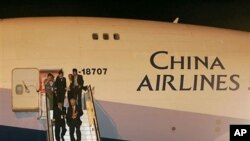After the global slump in air travel two years ago, Asian airlines are flying high again, adding more routes and ordering more aircraft. But one thing is missing: the people who know how to fly the planes.
The International Air Transport Association says passenger traffic in the Asia-Pacific rose nearly 80 percent in the first nine months of the year from the same period last year.
Not only is the market for airline seats hot, so is the job market for pilots. The International Civil Aviation Organization says the region has the capacity to train only 35 percent of its annual pilot requirements.
China alone needs thousands of new pilots in the next few years. Last month, China Southern Airlines, the country's largest carrier, said it will start a fast-track pilot training program that will take only two-and-a-half years, instead of the usual four.
Andrew Herdman is the director-general of the Association of Asia Pacific Airlines, which represents 17 international carriers.
"Some airlines are growing at double digits, particularly in China and other places," says Herdman. "They are the ones who are doing the hiring. But by the same token, there are a number of fast-growing carriers in the Middle East who have placed significant orders for aircraft and are also in the market to recruit pilots."
India is expected to become the third-largest aviation market in the world in less than two decades. This week, Air India and Jet Airways said they will lease 35 new planes from Airbus. Last month, budget carrier SpiceJet ordered 30 Boeing 737-800 planes.
But the Indian aviation sector is already straining to find pilots. Air India Express, the state-owned carrier's budget subsidiary, had to cancel flights to the Middle East in September because of a lack of pilots.
Some airline safety experts say the shortage could pose risks because pilots may be made to fly more routes and new pilots do not have enough flying experience. In September, Chinese authorities said they found more than 200 pilots had falsified their work histories between 2008 to 2009.
Bigger airlines such as Cathay Pacific and Singapore Airlines train their own pilots who then stay for many years with the company. But newer, faster growing airlines have tended to take a short cut by poaching pilots from other companies. In July, more than 20 Philippine Airlines pilots resigned to take higher paying jobs overseas, disrupting air travel in the country.
Herdman says it takes several years to train a commercial pilot.
"You can learn to fly in terms of a private pilot's license in a matter of months, but to get to commercial pilot's license and to get on to larger aircrafts and so on obviously takes years," Herdman says. "The overall training period to produce people who are qualified to fly large commercial jets is made in several years."
Last month, an Indian government investigation said a co-pilot sent an Air India jet into a steep dive when he panicked after accidentally hitting the controls. The 26-year-old pilot had less than 1,000 flying hours. In the United States, new pilots at major airlines typically have about 4,000 flying hours.
Shortage of Pilots Cools Asia's Hot Airline Market






